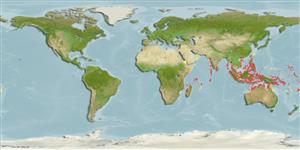Teleostei (teleosts) >
Eupercaria/misc (Various families in series Eupercaria) >
Labridae (Wrasses) > Corinae
Etymology: Halichoeres: Greek, als, alis = salt + Greek, choiros = pig (Ref. 45335).
More on author: Bleeker.
Environment: milieu / climate zone / depth range / distribution range
Ecology
Marine; reef-associated; depth range 5 - 15 m (Ref. 90102). Tropical
Indo-West Pacific: known at present only from Sri Lanka to Indonesia. Male Halichoeres nebulosus and Halichoeres margaritaceus have always been misidentified as Halichoeres kawarin, which may be responsible for attributing a greater range to this species.
Size / Weight / Age
Maturity: Lm ? range ? - ? cm
Max length : 12.0 cm TL male/unsexed; (Ref. 48636)
Identified by cheek and body patterns. Most similar to H. binotopsis and is best distinguished by the more angular versus horizontal cheek lines (Ref. 48636).
Found in shallow coastal reefs, mainly rock substrates with soft coral and algal growth. Occurs in small loose groups dominated by a large male (Ref. 48636). May also be found solitary (Ref. 90102).
Life cycle and mating behavior
Maturity | Reproduction | Spawning | Eggs | Fecundity | Larvae
Distinct pairing during breeding (Ref. 205).
Randall, J.E., 1980. Two new Indo-Pacific labrid fishes of the genus Halichoeres, with notes on other species of the genus. Pac. Sci. 34(4):415-432. (Ref. 2136)
IUCN Red List Status (Ref. 130435: Version 2024-1)
Threat to humans
Harmless
Human uses
Fisheries: commercial; aquarium: commercial
Tools
Special reports
Download XML
Internet sources
Estimates based on models
Preferred temperature (Ref.
123201): 26.6 - 29.2, mean 28.7 °C (based on 2004 cells).
Phylogenetic diversity index (Ref.
82804): PD
50 = 0.5000 [Uniqueness, from 0.5 = low to 2.0 = high].
Bayesian length-weight: a=0.00977 (0.00468 - 0.02039), b=3.09 (2.92 - 3.26), in cm total length, based on LWR estimates for this Genus-body shape (Ref.
93245).
Trophic level (Ref.
69278): 3.4 ±0.5 se; based on size and trophs of closest relatives
Resilience (Ref.
120179): High, minimum population doubling time less than 15 months (Preliminary K or Fecundity.).
Fishing Vulnerability (Ref.
59153): Low vulnerability (10 of 100).
Nutrients (Ref.
124155): Calcium = 108 [64, 190] mg/100g; Iron = 0.795 [0.451, 1.497] mg/100g; Protein = 18.5 [15.6, 20.7] %; Omega3 = 0.152 [0.094, 0.248] g/100g; Selenium = 19.9 [11.4, 37.2] μg/100g; VitaminA = 153 [47, 567] μg/100g; Zinc = 1.9 [1.3, 3.0] mg/100g (wet weight);
